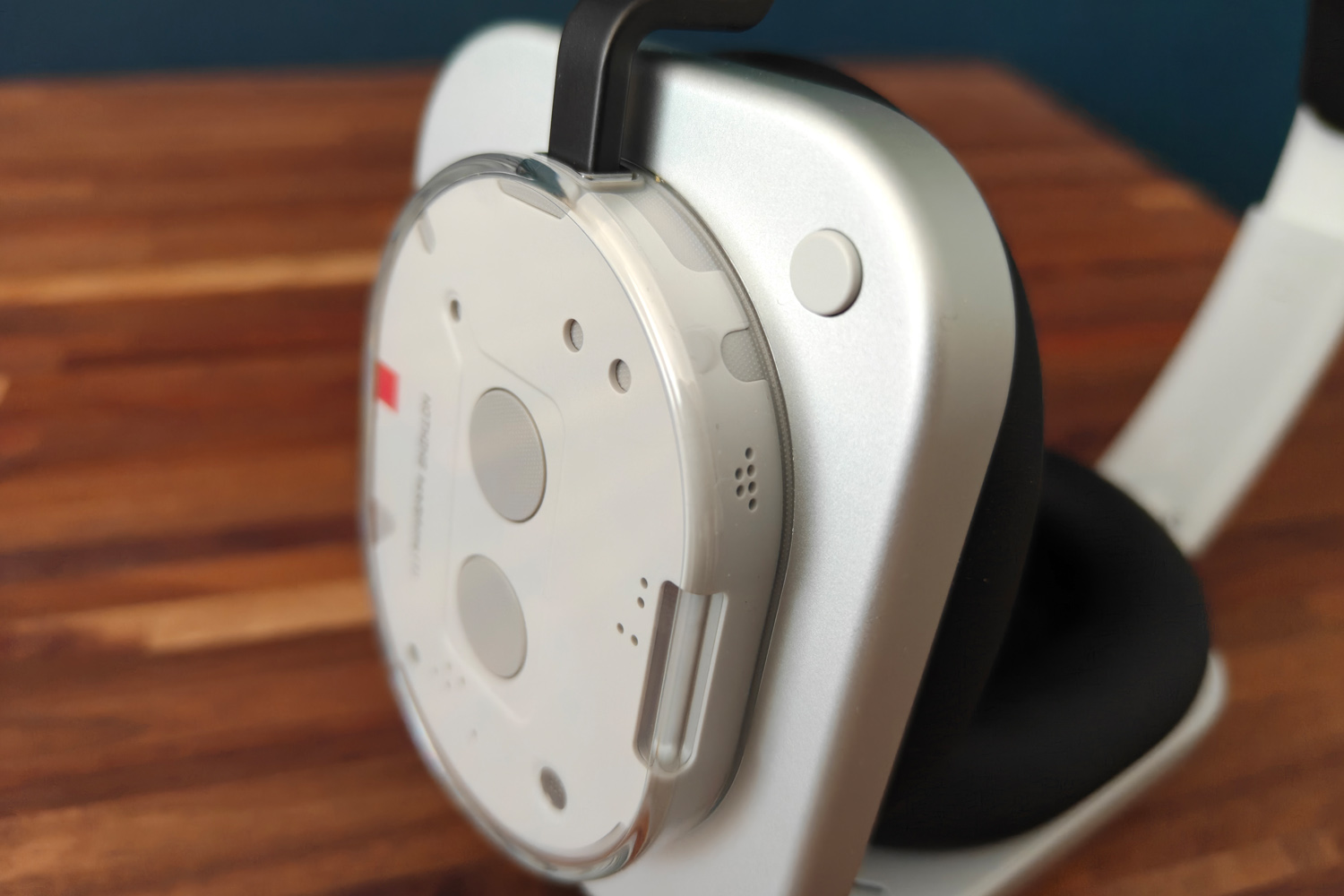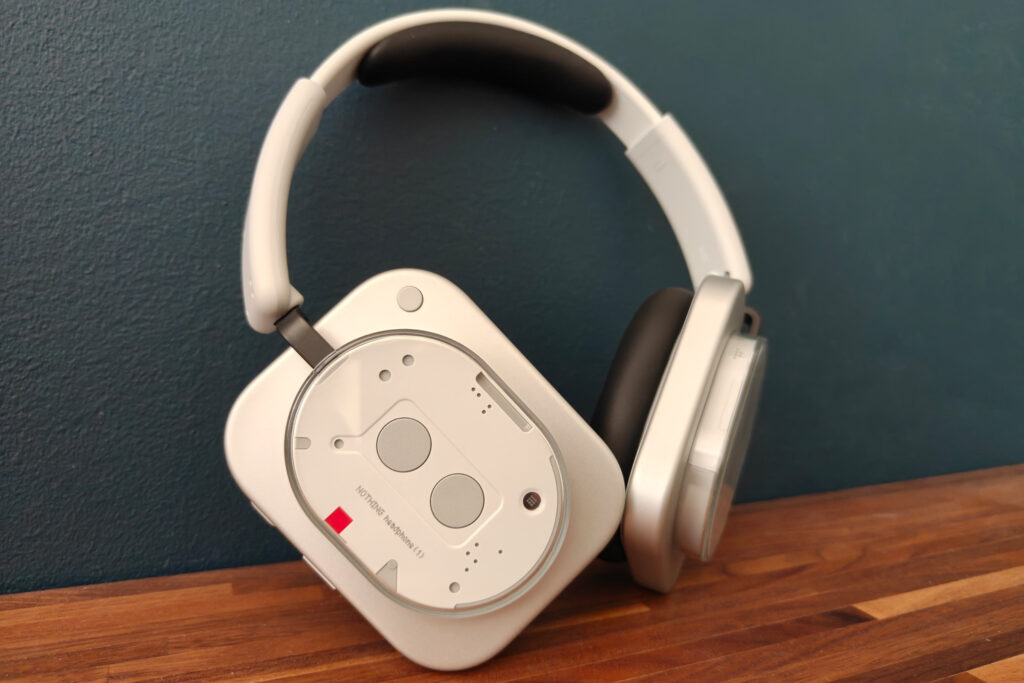Introduction
It was only a matter of time, wasn’t it? Having cut its teeth on multiple generations of true wireless earphones, burgeoning tech brand Nothing has finally taken a stab at its first pair of over-ears. Headphone (1) evolves the firm’s signature see-through styling and ditches touch inputs for intuitive physical controls, while speaker specialist KEF has lent an audio helping hand.
These eye-catching cans represent a change of tactics, though. Instead of sitting in Nothing’s established budget territory, Headphone (1) is heading upmarket to take on the best headphone front runners.
At $299/£299/€299 they undercut the usual suspects from Sony, Bose et al – but clash directly with previous-gen greats like the Sony XM5, Bowers Px7 S2e and Sennheiser Momentum 4 Wireless. All are still capable of going a few rounds against a young upstart. Has Nothing done enough here to stand out from the pack on more than looks alone?
Design & comfort: hip to be square
There’s really no mistaking Headphone (1) for anything but a Nothing product, with transparent ear cups that proudly show off a mix of geometric shapes and textures that hint at the electronics underneath. I get cassette tape vibes, if you’re old enough to know what those are.
The circle-meets-square shape is pretty out there, especially if you go for the white version; slap on some silver face paint and your Dr Who Cybermen cosplay is basically complete. The black model is only a little subtler. Few over-ear headphones stray so far into fashion statement territory. It’ll surely prove divisive, even among Nothing fans, but I like that the firm is willing to take risks. Fair play for resisting the urge to add glyph lighting LEDs, too – although given Phone 3 has ditched them in favour of a dot matrix, maybe that didn’t take much restraint after all.
Elsewhere things are a little more traditional, with oval-shaped ear cushions stuffed with memory foam and lined with faux leather for maximum sound isolation (at the cost of sweaty ears after prolonged listening sessions). The head cushion gets the same treatment, while the headband slides smoothly to adjust the fit. The ear cups then have tilting, pivoting arms that can each turn 90 degrees, letting you wear the headphones flush around your neck – handy, as it doesn’t fold for travel. Even with the headband at its most extended, though, I found the square parts would butt into my chin more than a regular-shaped pair might.
Comfort was otherwise pretty good, with just the right amount of clamping force and enough padding in all the right places that I could wear them for an entire work day and not feel worse for it once I’d clocked off. That’s a big deal, as at 329g these are heavier than pretty much all of the class leaders. They would definitely shift around on my head when I was running, so I would’t recommend them for exercise.
Some of that weight can be chalked up to the metal used for the square parts of each ear cup. Everything else is made from polycarbonate. Nothing knows a thing or two about picking plastics that don’t feel cheap, of course, so Headphone (1) largely holds its own on the materials front against similarly-priced rivals. I’m honestly a bit surprised it went to the effort of getting an IP rating, as I rarely see one on over-ear headphones; IP52 is pretty basic, but means you don’t have to worry about sweat doing damage.
Features & battery: button it

Open the box and you’ll find the Headphone (1) nestled in its bundled hard-shell carry case, which has a fairly large footprint but is slim enough to slide easily in and out of a rucksack. It’s got a mesh pocket for stashing all the cables you could need. USB-C and 3.5mm are included for charging and analogue listening; you’ll find ports for both on the right ear cup, next to the power switch.
Physical controls are the order of the day here, with real thought having gone in to how you operate them all by touch alone. You spin the chunky roller to adjust volume, click it in to play or pause tracks, and long-press it to swap between noise cancelling modes. Nudging the slender Paddle button left or right skips tracks forward and backward – and holding it in fast-forwards or rewinds whatever’s playing, if you media player supports it. I’ve found it very intuitive, and love not having to worry about overly sensitive touch surfaces accidentally skipping songs.
The button that launches your phone’s smart assistant lives on the outer part of the ear cup. On Nothing phones starting with Phone 3, it can be programmed to channel hop between different audio apps and favourites, or record a voice note with a long-press and send it straight to Nothing’s Essential Space app. I like the idea of jumping between podcasts and Spotify playlists without having to reach for my phone, though I’ve not had the chance to test this out ahead of Phone 3’s launch.
Headphone (1) is quick to connect over Bluetooth 5.3, with Google Fast Pair and Microsoft Swift Pair both on board. It’s got dual connectivity for fast swapping between two devices, too. You’ll have to head for Nothing’s X app if you want to swap from AAC or SBC streaming (whichever your kit defaults to) to the higher quality LDAC.
Voice calls are clear enough, with four of the six internal mics and some clever algorithms able to keep wind noise to a minimum while outdoors. I can’t fault the wear detection, either; it never threw a false positive and paused my songs while I was moving.
Nothing earns praise for battery life, too. I came very close to the firm’s claimed 35 hours of ANC-on listening, which is a few hours more than either the Sony XM6 or Bowers Px7 S3 can manage – despite costing considerably more. There’s easily enough juice here for a long-haul flight, and all the airport faff on either side. Disable noise cancelling and it’ll do 80 hours per charge, while a five minute top-up is enough for over two more hours of ANC streaming.
Sound quality and noise cancelling: we’re in the big leagues now
Without keen pricing to fall back on, the Headphone (1) has nowhere to run when it comes to performance. It gets off to a good start, with respectable noise cancelling ability. The sounds of next door’s builders buzz-sawing through patio tiles were easily drowned out with music at a modest volume, and it all but deleted the low-frequency drone of my desk fan. Wind noise from having it blowing directly at my face wasn’t a big deal either.
The distinctive design posed a slight dilemma in how to test them on public transport or busy public spaces, but I managed to stay incognito long enough to confirm noisy subway carriages aren’t a major concern. While Bose and Sony still set the standard, coping better with sudden changes in background noise and chatty fellow passengers, Nothing has largely kept in step with similarly-priced rivals.
Sound quality is a similar story. The 40mm dynamic drivers deliver a lush, energetic presentation that isn’t short on volume and doesn’t skimp on low-end shove, even before you reach for the Bass Enhance settings. The sub-bass synths on Modestep’s Shutting down slice through the mix, without taking away from the mids. My review sample showed some specific low-frequency distortion at extreme volumes with ANC enabled, but after speaking to other testers this seems to be an isolated issue. I’m waiting for Nothing to respond.
KEF’s tuning curve definitely leans towards a fun, v-shaped sound that won’t sway audiophiles searching for neutrality or an analytical listen. That’s not to say mid-range detail is lacking or pushed to the back of the mix; Zakk Wylde’s thundering vocals still take precedence on Black Label Society’s Stillborn. The closed-back drivers don’t have the widest soundstage, but tunes don’t sound overly enclosed or ‘inside your head’ either.
This is an enjoyable listen overall, but Headphone (1) can’t quite match the high frequency precision of Sennheiser’s latest. It avoids sounding muddy, but the breathy vocals of Billie Eilish’s Everything I Wanted didn’t sparkle in quite the same way. Disabling noise cancelling sees this end of the spectrum sharpen up, but at the expense of bass presence. I definitely preferred to listen with ANC enabled.
Interface: solve for X
The latest version of Nothing’s X companion app doesn’t mix things up all that much, having previously ditched the dot matrix font for something a little easier to read. Anyone that’s used a pair of the firm’s wireless earbuds will recognise most of the features on offer, including customisable controls, a choice of noise cancelling modes, and a prominent battery life indicator right on the home screen – handy, as the headphones won’t announce how much juice is left when you turn ’em on.
You have to dig a bit to find wear detection, the low latency mode, and dual device connectivity. This is also where you’ll apply firmware updates and access the Find My Headphones tool, which plays a loud noise should you misplace them.
The big new addition is spatial audio, with fixed and head-tracking virtual upmixing on tap. The former helps expand the soundstage, creating the sensation your tunes are coming from further away. The latter pins sound in front of you, like you’re at a gig or concert. It’s as love-it-or-hate-it as any other take of the tech I’ve tried, and I’m not keen on the way treble takes extra presence with it enabled.
I appreciate Nothing bringing is two-stage equaliser across from its in-ear range. There’s a simple three-way slider for bass, mid and treble, plus a couple of presets that cover the basics; headphone geeks should head to the advanced EQ, which has choice of simple and advanced (8-band) EQ, the ability to make multiple profiles for different genres, and a QR code reader for importing community-made resets.
Bass enhance also reappears, with five levels to pick from. I found level two could be a bit much for certain heavy electronic tracks, but it goes all the way to five if you want a skull-shaking low-end – and don’t mind losing some definition elsewhere in the mix to bloated bass frequencies.
Nothing Headphone 1 verdict
If you’re already sold on Nothing’s styling, you’ll be more than happy with how the Headphone (1) performs. It has punchy audio, effective noise cancelling, and very competitive battery life. It’s no class leader on any one front, though, and is far from an impulse purchase like the firm’s cheaper earbuds.
You could spend similar money on the outgoing Sony XM5 if you want superior ANC, and the Sennheiser Momentum 4 Wireless may be a better choice for critical listening. But if you like your tech to also make a fashion statement, this is basically in a class of one.
Nothing Headphone 1 technical specifications
| Drivers | 40mm dynamic |
| ANC | Yes, adaptive |
| Bluetooth version | Bluetooth 5.3 |
| Codecs supported | SBC, AAC, LDAC |
| Durability | IP52 |
| Battery life | 35 hours (ANC on) / 80 hours (ANC off) |
| Dimensions | 174x78x189mm, 329g |
Read the full article here
